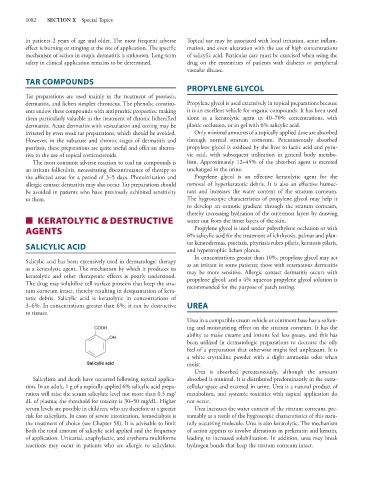Page 1096 - Basic _ Clinical Pharmacology ( PDFDrive )
P. 1096
1082 SECTION X Special Topics
in patients 2 years of age and older. The most frequent adverse Topical use may be associated with local irritation, acute inflam-
effect is burning or stinging at the site of application. The specific mation, and even ulceration with the use of high concentrations
mechanism of action in atopic dermatitis is unknown. Long-term of salicylic acid. Particular care must be exercised when using the
safety in clinical application remains to be determined. drug on the extremities of patients with diabetes or peripheral
vascular disease.
TAR COMPOUNDS
PROPYLENE GLYCOL
Tar preparations are used mainly in the treatment of psoriasis,
dermatitis, and lichen simplex chronicus. The phenolic constitu- Propylene glycol is used extensively in topical preparations because
ents endow these compounds with antipruritic properties, making it is an excellent vehicle for organic compounds. It has been used
them particularly valuable in the treatment of chronic lichenified alone as a keratolytic agent in 40–70% concentrations, with
dermatitis. Acute dermatitis with vesiculation and oozing may be plastic occlusion, or in gel with 6% salicylic acid.
irritated by even weak tar preparations, which should be avoided. Only minimal amounts of a topically applied dose are absorbed
However, in the subacute and chronic stages of dermatitis and through normal stratum corneum. Percutaneously absorbed
psoriasis, these preparations are quite useful and offer an alterna- propylene glycol is oxidized by the liver to lactic acid and pyru-
tive to the use of topical corticosteroids. vic acid, with subsequent utilization in general body metabo-
The most common adverse reaction to coal tar compounds is lism. Approximately 12–45% of the absorbed agent is excreted
an irritant folliculitis, necessitating discontinuance of therapy to unchanged in the urine.
the affected areas for a period of 3–5 days. Photoirritation and Propylene glycol is an effective keratolytic agent for the
allergic contact dermatitis may also occur. Tar preparations should removal of hyperkeratotic debris. It is also an effective humec-
be avoided in patients who have previously exhibited sensitivity tant and increases the water content of the stratum corneum.
to them. The hygroscopic characteristics of propylene glycol may help it
to develop an osmotic gradient through the stratum corneum,
thereby increasing hydration of the outermost layers by drawing
■ KERATOLYTIC & DESTRUCTIVE water out from the inner layers of the skin.
AGENTS Propylene glycol is used under polyethylene occlusion or with
6% salicylic acid for the treatment of ichthyosis, palmar and plan-
SALICYLIC ACID tar keratodermas, psoriasis, pityriasis rubra pilaris, keratosis pilaris,
and hypertrophic lichen planus.
In concentrations greater than 10%, propylene glycol may act
Salicylic acid has been extensively used in dermatologic therapy as an irritant in some patients; those with eczematous dermatitis
as a keratolytic agent. The mechanism by which it produces its may be more sensitive. Allergic contact dermatitis occurs with
keratolytic and other therapeutic effects is poorly understood. propylene glycol, and a 4% aqueous propylene glycol solution is
The drug may solubilize cell surface proteins that keep the stra- recommended for the purpose of patch testing.
tum corneum intact, thereby resulting in desquamation of kera-
totic debris. Salicylic acid is keratolytic in concentrations of
3–6%. In concentrations greater than 6%, it can be destructive UREA
to tissues.
Urea in a compatible cream vehicle or ointment base has a soften-
COOH ing and moisturizing effect on the stratum corneum. It has the
ability to make creams and lotions feel less greasy, and this has
OH
been utilized in dermatologic preparations to decrease the oily
feel of a preparation that otherwise might feel unpleasant. It is
a white crystalline powder with a slight ammonia odor when
Salicylic acid moist.
Urea is absorbed percutaneously, although the amount
Salicylism and death have occurred following topical applica- absorbed is minimal. It is distributed predominantly in the extra-
tion. In an adult, 1 g of a topically applied 6% salicylic acid prepa- cellular space and excreted in urine. Urea is a natural product of
ration will raise the serum salicylate level not more than 0.5 mg/ metabolism, and systemic toxicities with topical application do
dL of plasma; the threshold for toxicity is 30–50 mg/dL. Higher not occur.
serum levels are possible in children, who are therefore at a greater Urea increases the water content of the stratum corneum, pre-
risk for salicylism. In cases of severe intoxication, hemodialysis is sumably as a result of the hygroscopic characteristics of this natu-
the treatment of choice (see Chapter 58). It is advisable to limit rally occurring molecule. Urea is also keratolytic. The mechanism
both the total amount of salicylic acid applied and the frequency of action appears to involve alterations in prekeratin and keratin,
of application. Urticarial, anaphylactic, and erythema multiforme leading to increased solubilization. In addition, urea may break
reactions may occur in patients who are allergic to salicylates. hydrogen bonds that keep the stratum corneum intact.

